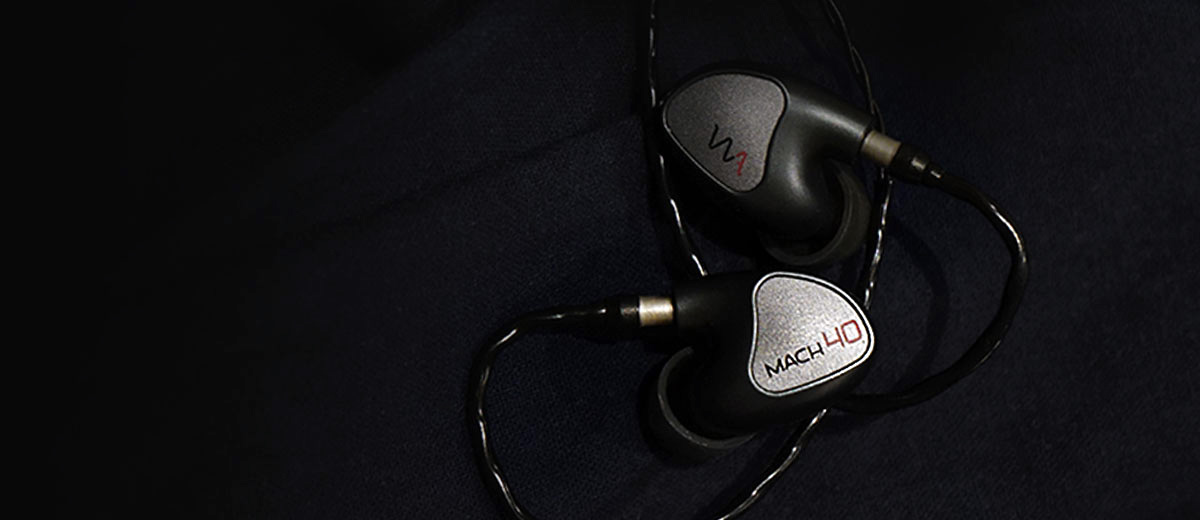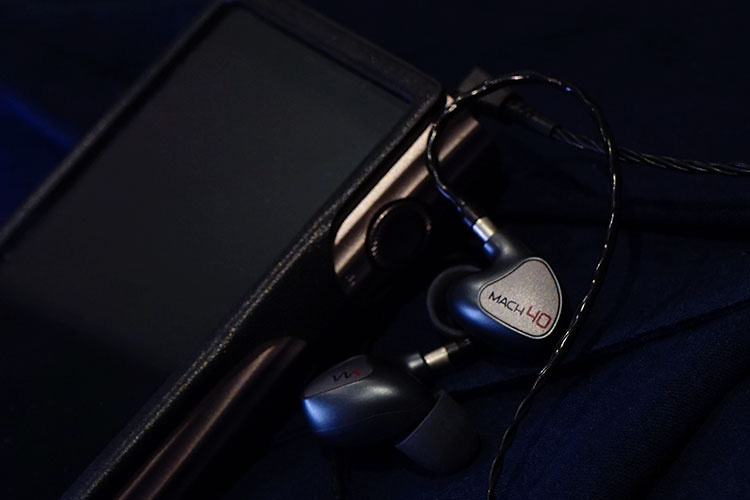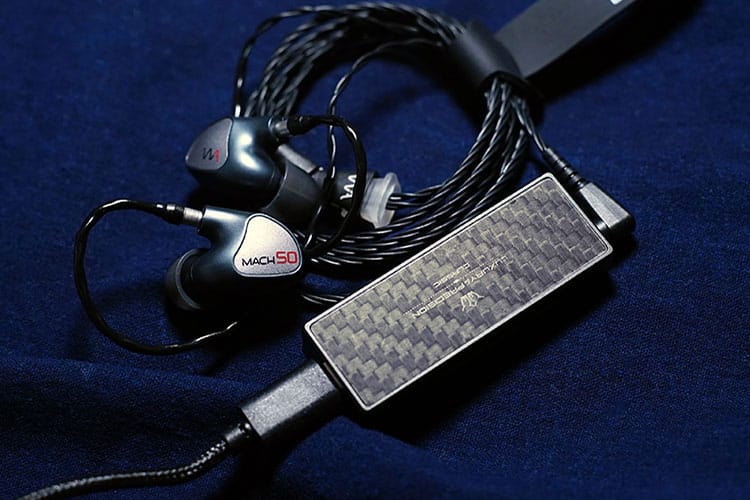Synergy
Efficiency
Measuring 30Ω in impedance and 100dB @1kHz in sensitivity, the MACH 40 seems to be quite power-demanding. Indeed, it is quiet for background noise when tested on the FiiO K7 amplifier with the high gain turned on.
Its smooth tuning and 100% BA configuration allow pairing with dongles and smaller outputs to sound full and dynamic, the slightly forwarded vocal frequencies also help maintain better clarity.
With more power fed to the MACH 40, it gets clearer and more opened up, yet it maintains a smooth tuning that balances the whole frequency spectrum naturally.
The tuning remains quite consistent with different sources but the speed and finesse will be improved upon powering with stronger and faster sources.
Pairings
Testing with my MacBook and my phones, the mid-lows have a slightly thick texture and the overall clarity is satisfactory.
It sounds engaging with streaming content and the lines can be heard clearly when watching Netflix. However, it may sound congested with larger ensembles, which would require the MACH 40 to be powered by a faster, more definitive source.
The same on the Luxury & Precision W2, the pairing sounds fairly engaging and resolving, but it would definitely be more engaging if the mid-bass is more layered.
Putting the MACH 40 on the FiiO K9 Pro ESS, the MACH 40 sounds cleaner and faster. The bass attacks punchily with an elaborate decay, creating a relaxing vibe along with the well-weighted vocal image.
The separation power and definition power in the mid-range are much enhanced when there is more power and more micro details can be heard. At the same time, it unleashes more air in the upper register without bringing in harshness.
When testing with the Shanling M7 which is quite a powerful portable source, it stretches the perceived stage wider and deeper. The strength of the MACH 40 is with pop and blues, where the instruments require more power and presence. The M7 can power it beautifully even on single-ended output.
Select Comparisons
Westone Audio MACH 60
$1099
Technical
With a dual low, dual mids, dual treble BA configuration, the MACH 60 has a wider frequency response and an even higher impedance rating measured at 100db @1kHz in sensitivity and with a 35Ω impedance rating.
This allows its tonality to be consistent on different outputs but is more power-demanding compared to the MACH 40 which can be more easily driven from weak sources.
Design
The MACH 60 and MACH 40 have an identical design and the same stock cable, the only difference is the model number on top.
Performance
Comparing the two IEMS on the RME ADI-2 Pro, the Mach 60 can capture more details and sound more balanced than the Mach 40.
Being not as bright and extended in the treble and having a larger bass driver ratio, the MACH 40 leans more towards the lower frequencies and is more limited to tracks with fewer instruments, feeling more dampened in the upper frequencies at the same time.
That makes it sound more elaborate with bass instruments and sound less intrusive, and the MACH 60 has better strength in staging size and overall detail retrieval power.
The MACH 60 is more capable of accurately defining more instruments in the mix, it also sounds swifter with higher-pitched voices with more air and details in the harmonics, compared to MACH 40 which is tuned to be sweeter and more rounded.
When focusing just on the vocals, especially with low-pitched singers, the MACH 40 performs as well as the MACH 60, if not quite as elaborative.
Despite the MACH 60 being a winner when plugged into desktop sources, its performance is much discounted with weaker portable sources. When tested with the HiBy RS2 the MACH 60 sounds much smoother whilst the detail retrieval level is comparable to the MACH 40.
Although the comprehensive performance is stronger on the MACH 60, if the main usage scenario is with phones and laptops listening in a noisier outdoor environment, the MACH 40 would be a better match and is more cost-efficient.
Westone Audio MACH 50
$799
Technical
The MACH 50 has 5 balanced armature drivers in the hood and features a 3-way configuration using a pair of tweeters, dual mids, and 1 single bass driver, same as other “Premium Bass” line items that use only 1 BA for bass reproduction.
The MACH 50 is rated 110dB in sensitivity and 32Ω in impedance, which makes it slightly more sensitive than the MACH 40.
Design
Again, the design on the MACH 50 and MACH 40 is basically the same, with the same stock cable as well. Visually the only difference is the model number on top of the metallic faceplate but if you are doing a blind test, you could easily distinguish the two.
Performance
The MACH 50 in general, feels more intensive in the bass and more sensitive. The bass and the treble on MACH 50 are more elevated which strengthens the dynamics.
While being more sensitive, it can be more efficiently paired with various mobile devices to sound more detailed and energetic, compared to the MACH 40 which sounds softer and more relaxing.
When testing on the Cayin RU6, the detail retrieval power on the MACH 50 is stronger and it sounds more transparent in the upper register.
The bass impact is also fuller, layered, and rumbles more with the MACH 50, whereas the MACH 40 renders the bass smoother but more conservatively.
When paired with the ADI-2 Pro and K9 Pro ESS, there is sufficient power for both IEMS and the MACH 40 comes closer to the MACH 50’s performance technically, though they exhibit different signatures.
The MACH 40 is more focused on the midrange frequencies and the vocal and guitar imaging stands out more. It is less bright and accurate compared to the MACH 50, also not as meaty and deep-reaching, and punchy in the bass. However, the bass sounds more neutral, controlled, and elaborated in the decay.
The MACH 50 is more versatile with its higher sensitivity for pairing with different gears, and it can sound detailed and powerful on the bass even on smaller outputs.
However, if you are a vocal lover or seeking a more rounded, relaxing, soothing tone and if you possess powerful sources, then I may recommend the MACH 40 over the 50.

Our Verdict
The Westone Audio MACH 40 has a rich, cohesive tuning that articulately blends the vocalist and instruments in the music together instead of pulling them apart for clarity.
You can hear different backing instruments through the music, blending with the vocal but not over it, and the vocal performance sounds authoritative.
The higher-end models are more resolving but when listening outdoors, the MACH 40 could be more engaging and fun with its tone, and it would make a good pairing with highly defined, clean, and powerful DAPs.
Westone Audio MACH 40 Technical Specifications
- 3-way Passive Crossover
- DRIVERS: Four Balanced-Armature Drivers
- FREQ RESPONSE: 10Hz – 20kHz
- SENSITIVITY: 100dB @1kHz
- IMPEDANCE: 30 Ohms @1kHz







